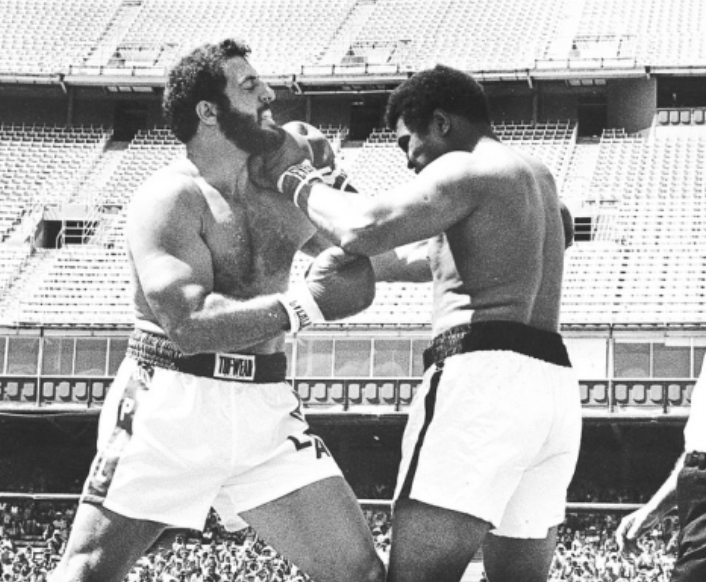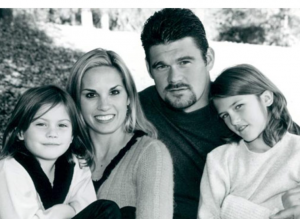Featured Articles
Super Bowl Sunday Special Edition: Remembering Lyle Alzado and Shane Dronett

Lyle Alzado played in the 1978 Super Bowl as a member of the Denver Broncos and in the 1984 Super Bowl as a member of the Los Angeles Raiders. Shane Dronett, like Alzado a defensive end who tragically died young, was a key component of the 1998 Atlanta Falcons squad that advanced to Super Bowl XXXIII.
If football hadn’t come calling, Alzado and Dronett would have likely made their mark in the sweet science. Both were outstanding amateur boxers.
Lyle Alzado was born in Brooklyn, the son of a Spanish-Italian father and a Jewish mother of Polish descent. At Lawrence High School in the Long Island village of Cedarhurst, he excelled on the gridiron, but his grades were so poor that no major football school was willing to take a chance on him. After a stint at a junior college in Texas, he surfaced at Yankton College in South Dakota, a small private college that no longer exists; it went bankrupt in 1984 and is now the site of a federal prison.
One guesses that Alzado missed a lot of classes at Yankton because he popped up repeatedly in Omaha,160 miles away. He went there to resume his amateur boxing career. A story in an Omaha paper reported that he was 27-1 in New York area rings before heading west. As Alzado’s legend grew, so also did his ring record which was inflated in news reports to 44-1.
In Omaha, Alzado frequently sparred with Ron Stander. On Feb. 4, 1969, they fought in a semi-final match-up in the Omaha City Golden Gloves tournament. Stander got the nod, a decision that was roundly booed according to a story in the Lincoln Star.
Ron Stander lived across the river from Omaha in Council Bluffs, Iowa – hence his nickname, the Bluffs Butcher. As a pro, his signature win was a fifth-round KO of Earnie Shavers. He went on to fight Joe Frazier in the first and only heavyweight title fight ever staged in Omaha.
The Bluffs Butcher talked a good fight. “If we were fighting in an alley,” he said, “Frazier wouldn’t stand a chance.” But they didn’t fight in an alley and Joe butchered him. Stander was a bloody mess when his corner pulled him out after four rounds.
Alzado was selected in the fourth round of the 1971 NFL Draft and went on to become a cornerstone of Denver’s “Orange Crush” defense. In 1977, Denver’s Super Bowl season, Alzado was named the NFL Defensive Player of the Year in a poll by the United Press.
The Broncos lost the Jan. 19, 1978 Super Bowl to the Cowboys by a 27-10 score despite a strong game by Alzado who constantly pressured quarterback Roger Staubach while registering two sacks.
Alzado had another fine season in 1978, earning first-team All-Pro honors. By then, his exploits in the ring as an amateur boxer had become well-publicized and an enterprising promoter arranged a match with Muhammad Ali who had regained the world heavyweight title the previous year in his second meeting with Leon Spinks.
An 8-round exhibition, the match played out on July 14, 1979 at Denver’s Mile High Stadium, home of the Broncos, on a sweltering Saturday afternoon when the temperature reached 100 degrees. Contested before 20,000 (far below expectations), the match was tame, but Alzado made a credible showing and Ali would pay him the ultimate compliment, saying he had the makings of a champion if he chose to pursue a boxing career full-time. (Who would have guessed that when he and Ron Stander were sparring at a little boxing gym in Omaha that one would go on to share the ring with the most famous man on the planet and the other with his famous arch-rival?!)
Alzado was mired in a contract dispute with the Broncos when he fought Ali and the club shipped him off to the Cleveland Browns where he had three solid seasons. In 1982, he was traded to the former and future Oakland Raiders who were in their first season of their Los Angeles phase.
The Raiders with their bad-ass reputation and Lyle Alzado were a perfect fit. In Alzado’s first season in LA, with future Hall of Famer Howie Long manning the opposite flank, the Raiders led the league in sacks. The following year, Alzado was one of the linchpins of the Raiders team that won the NFL’s ultimate prize, knocking off the favored Washington Redskins 38-9 in the Super Bowl.
Shane Dronett
Shane Dronett, who grew up in Bridge City, Texas, took up boxing at the age of 11. As a senior in high school, he was a Texas Golden Gloves champion. He also excelled on the gridiron, earning All-State honors as a tight end and linebacker.
Dronett enrolled at the University of Texas where he grew into a six-foot-six, 265-pound defensive end. He cracked the starting lineup midway through his freshman season, was All-Conference as a sophomore and again as a junior when he made several All-America teams and then left school for the NFL with a year of eligibility remaining.
Selected in the second round of the 1992 NFL Draft by the Denver Broncos, Dronett had 19 ½ sacks in his first three seasons and set a franchise record in 1994 with four blocked field goals. When his production tailed off, the Broncos let him go and, similar to Alzado, he would enjoy a late career surge with a new team, in his case the Falcons.
Dronett couldn’t get Atlanta over the hump in the Jan. 31, 1999 Super Bowl. The Falcons fell to the Broncos, 31-19. But he played so well that year and again the following year that he was tendered a five-year, $20 million contract. It proved to be a bad deal for the Falcons as, bedeviled by knee and shoulder injuries, he played only one more full season.
—
Lyle Alzado and Shane Dronett had a lot in common besides the fact they were outstanding amateur boxers who played defensive end for the Denver Broncos. On the practice field they were known for their fiery personalities. And both were not far removed from their playing days when they left this mortal earth, their lives cut short by brain disease.
Alzado, who parlayed his notoriety on the football field into an acting career, spent the last year of his life on a mission to educate others about the dangers of steroid use. In a July 8, 1991 Sports Illustrated cover story, he confessed that his denials about using anabolic steroids and human growth hormones were a big lie. He blamed the steroids on the inoperable brain tumor that was slowly eating away at him, convinced that the drugs had compromised his immune system. He died on May 14, 1992, at age 43 at the home of his fourth wife in Lake Oswego, Oregon, and was buried in Portland.
The circumstances surrounding the death of Shane Dronett are more distressing.
In 2006, Dronett began acting erratically; at various times confused, delusional, and paranoid. Doctors discovered a small benign tumor on his brain. They removed it, but Dronett’s problems continued. On Jan. 21, 2009, at his home in Georgia, he brandished a handgun at his wife and then turned it against himself, committing suicide. He was 38 years old. He left behind two young daughters, the oldest of whom, Hayley, chose to remember her father from her younger days: “He was the best dad in the world.”
Dronett’s personality change was mindful of some retired boxers whose autopsies showed evidence of chronic traumatic encephalopathy (“CTE”), a progressive degenerative disease of the brain associated multiple concussions. “This was not the man I married,” said his wife, Christine, who consented to have his brain tissue examined by Boston University neuropathologist Dr. Ann McKee whose pioneering work and that of several of her colleagues is detailed in “Damage,” boxing writer Tris Dixon’s widely acclaimed new book. Dr. McKee confirmed that Shane Dronett had CTE.
—
Regarding Lyle Alzado, no link has been found between steroid use and brain cancer. However, by warning athletes away from performing-enhancing drugs, Alzado performed a needed service. And likewise, the widow of Shane Dronett did her part to make the sport of football safer for future participants by willingly assisting Dr. McKee in her groundbreaking research which forced the NFL to acknowledge the seriousness of concussions and do something about it.
Perhaps Alzado and Dronett would have lived longer and left this world on a less sorrowful note if they had chosen a career in boxing instead of football, but then again, they became pillars of teams that made it all the way to the Super Bowl, America’s biggest annual sporting spectacle, and that must have been quite a rush.
To comment on this story in the Fight Forum CLICK HERE
-

 Featured Articles4 weeks ago
Featured Articles4 weeks agoThe Hauser Report: Zayas-Garcia, Pacquiao, Usyk, and the NYSAC
-

 Featured Articles3 weeks ago
Featured Articles3 weeks agoOscar Duarte and Regis Prograis Prevail on an Action-Packed Fight Card in Chicago
-

 Featured Articles2 weeks ago
Featured Articles2 weeks agoThe Hauser Report: Cinematic and Literary Notes
-

 Book Review2 weeks ago
Book Review2 weeks agoMark Kriegel’s New Book About Mike Tyson is a Must-Read
-

 Featured Articles4 weeks ago
Featured Articles4 weeks agoRemembering Dwight Muhammad Qawi (1953-2025) and his Triumphant Return to Prison
-

 Featured Articles6 days ago
Featured Articles6 days agoMoses Itauma Continues his Rapid Rise; Steamrolls Dillian Whyte in Riyadh
-

 Featured Articles3 weeks ago
Featured Articles3 weeks agoRahaman Ali (1943-2025)
-

 Featured Articles3 weeks ago
Featured Articles3 weeks agoTop Rank Boxing is in Limbo, but that Hasn’t Benched Robert Garcia’s Up-and-Comers


















